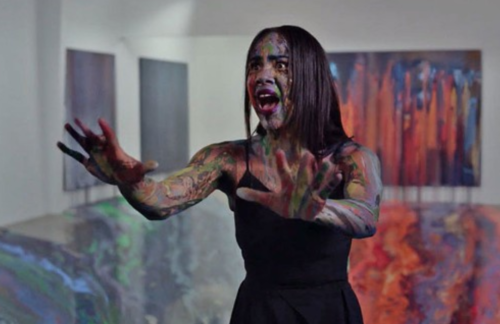Perhaps only feeling comfortable enough to get at his freakiest with Jake Gyllenhaal as his muse, mostly screenwriter Dan Gilroy has seen fit to, once again, sit behind the director’s chair after the collaborative success of 2014’s Nightcrawler. This, too, also co-starred his other favorite muse (/wife), Rene Russo, who appears as cutthroat art acquirer/dealer Rhodora Haze in Gilroy’s latest, Velvet Buzzsaw. The title also just so happens to be the name Rhodora gave her band in her more punk rock artist days, committed enough then to the purity of “just creating” to tattoo the moniker on her neck (complete with buzzsaw design).
In her constant orbit is feared and revered art critic Morf Vandewalt (Gyllenhaal), an effetely uppity gay man with bisexual tendencies solely when it comes to one of Rhodora’s righthand women at the Haze Gallery, Josephina (a somewhat annoying Zawe Ashton, seeming to do her best attempt at Rosario Dawson or Thandie Newton). Luckily–or perhaps unluckily–for him, Josephina is also at Art Basel, where our story begins, and has just been informed over the phone by her friend and constant wellspring of information, Coco (Natalia Dyer), that her artist boyfriend, Ricky, has been cheating on her. This makes her amenable to being flattered and wooed by Morf’s strange seduction (consisting of such compliments as, “Your skin. It’s the most beautiful cross between almond and saddle brown”) in Miami, despite the fact that he’s still dating his longtime boyfriend, Ed (Sedale Threatt Jr.).
Back in L.A., for some reason more of an art world hub than New York these days (but then, one supposes it has long been so, since the advent of Hockney), Josephina takes an additional blow to her ego when Rhodora demotes her after she’s late to the reception desk once more (no thanks to some narcing from art handler/self-declared artist Bryson [Billy Magnussen]). Her defense? Her discovery of a dead neighbor, Vetril Dease (Alan Mandell). When one of the police investigators on the case mentions to Josephina that Dease was a painter who wanted “everything thrown away,” her curiosity gets the better of her as she essentially feigns looking for the cat, but is more than likely hoping for a Vivian Maier-esque discovery–which, of course, she makes.
Revealing her findings to Morf before anyone, he assures her that the market for this type of thing would be huge, demanding to know who’s representing the still unnamed artist. Josephina asserts, “I do.” Naturally, her secret genius can’t remain secret for long, least of all to Rhodora, a bloodhound when it comes to sniffing out profitable paint. She’s certainly far more “prescient” than her rivals, including museum curator Gretchen (Toni Collette) and gallery owner Jon Dondon (Tom Sturridge). In fact, Rhodora seems to always be in sync with what Morf’s tastes are, even before his articles come out. The same goes for Dease, whose inventory she immediately seizes upon after daunting Josephina with her description of all the work it takes to claim ownership, inventory and catalogue–work she simply doesn’t have the expertise in. So the two forge an alliance and it’s off to the races, those races being a bidding war and feeding frenzy for the erstwhile obscure artist. Because the art world loves nothing more than deifying the “mired in mediocrity” during life narrative.
Wanting to control the wealth as much as possible, Rhodora decides to squirrel away a large portion of the inventory to make supply seem scarcer than it is. Enlisting Bryson to haul the cargo to a storage facility, his intuitive greed in opening the crates to steal some for himself leads to the film’s first casualty, setting the precedent for what the sinisterly haunted works are capable of, coming to life as though a higher budget version of that Are You Afraid of the Dark? episode where people get sucked into paintings.
The more profitable the art becomes, the more dangerous–for Dease exists in each of them, literally. Likely having something to do with the fact that he used his blood to mix in with the paint on every canvas (it’s, to be sure, a little creepier than Andy Warhol’s “oxidation” [read: piss] painting). With Morf being the only person able to comprehend what’s happening as the murders grow more gruesome, his particular brand of being harassed from the great beyond feels more pronounced than the others, with his own harsh critical words being thrown back at him at one point while in a soundproof room.
Meanwhile, the increasingly appetitive Josephina has grown bored with Morf, who is very clearly losing it, as she decides to move on to a new up and coming artist named Damrish (Daveed Diggs). Their alliance, both sexual and professional, soon falls apart, however, when he tells her he wants to go back to the art collective he started at. Josephina mocks him for turning his back on his looming fame, hissing, “What’s the point of art if nobody sees it?” Looking at her sadly, because she really never will get it–what drives the true and pure artist–Damrish just kisses her condescendingly on the forehead and walks away. To this end, Dease’s insistence upon never having his work seen by anyone else almost makes sense for escalating his seriousness about it to post-mortem serial killing. Why pervert it all with money and judgment from unworthy dolts? And, in truth, one is almost surprised Hilma af Klint didn’t do the same thing, especially after hearing any errant imbecilic comments about her work at the Guggenheim.





















